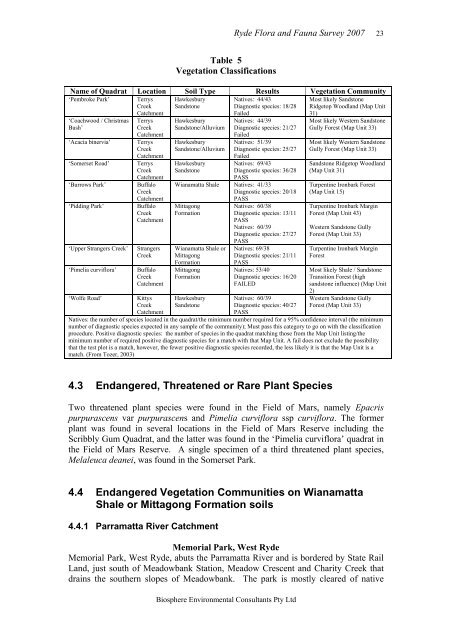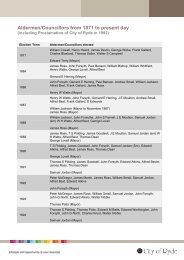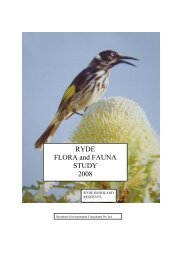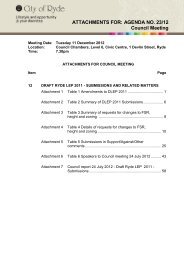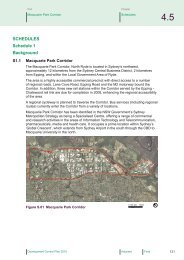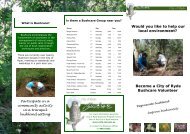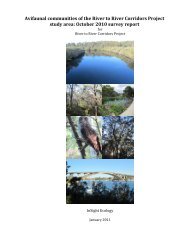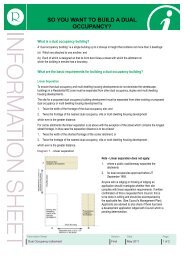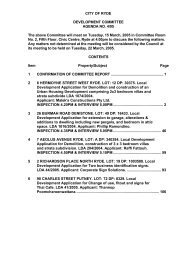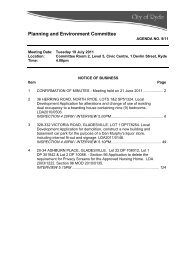RYDE FLORA and FAUNA STUDY 2007 - City of Ryde - NSW ...
RYDE FLORA and FAUNA STUDY 2007 - City of Ryde - NSW ...
RYDE FLORA and FAUNA STUDY 2007 - City of Ryde - NSW ...
You also want an ePaper? Increase the reach of your titles
YUMPU automatically turns print PDFs into web optimized ePapers that Google loves.
Table 5<br />
Vegetation Classifications<br />
Biosphere Environmental Consultants Pty Ltd<br />
<strong>Ryde</strong> Flora <strong>and</strong> Fauna Survey <strong>2007</strong> 23<br />
Name <strong>of</strong> Quadrat Location Soil Type Results Vegetation Community<br />
‘Pembroke Park’ Terrys<br />
Creek<br />
‘Coachwood / Christmas<br />
Bush’<br />
Catchment<br />
Terrys<br />
Creek<br />
Catchment<br />
‘Acacia binervia’ Terrys<br />
Creek<br />
Catchment<br />
‘Somerset Road’ Terrys<br />
Creek<br />
Catchment<br />
‘Burrows Park’ Buffalo<br />
Creek<br />
Catchment<br />
‘Pidding Park’ Buffalo<br />
Creek<br />
Catchment<br />
‘Upper Strangers Creek’ Strangers<br />
Creek<br />
‘Pimelia curviflora’ Buffalo<br />
Creek<br />
Catchment<br />
‘Wolfe Road’ Kittys<br />
Creek<br />
Catchment<br />
Hawkesbury<br />
S<strong>and</strong>stone<br />
Hawkesbury<br />
S<strong>and</strong>stone/Alluvium<br />
Hawkesbury<br />
S<strong>and</strong>stone/Alluvium<br />
Hawkesbury<br />
S<strong>and</strong>stone<br />
Natives: 44/43<br />
Diagnostic species: 18/28<br />
Failed<br />
Natives: 44/39<br />
Diagnostic species: 21/27<br />
Failed<br />
Natives: 51/39<br />
Diagnostic species: 25/27<br />
Failed<br />
Natives: 69/43<br />
Diagnostic species: 36/28<br />
PASS<br />
Wianamatta Shale Natives: 41/33<br />
Diagnostic species: 20/18<br />
Mittagong<br />
Formation<br />
Wianamatta Shale or<br />
Mittagong<br />
Formation<br />
Mittagong<br />
Formation<br />
Hawkesbury<br />
S<strong>and</strong>stone<br />
PASS<br />
Natives: 60/38<br />
Diagnostic species: 13/11<br />
PASS<br />
Natives: 60/39<br />
Diagnostic species: 27/27<br />
PASS<br />
Natives: 69/38<br />
Diagnostic species: 21/11<br />
PASS<br />
Natives: 53/40<br />
Diagnostic species: 16/20<br />
FAILED<br />
Natives: 60/39<br />
Diagnostic species: 40/27<br />
PASS<br />
Most likely S<strong>and</strong>stone<br />
Ridgetop Woodl<strong>and</strong> (Map Unit<br />
31)<br />
Most likely Western S<strong>and</strong>stone<br />
Gully Forest (Map Unit 33)<br />
Most likely Western S<strong>and</strong>stone<br />
Gully Forest (Map Unit 33)<br />
S<strong>and</strong>stone Ridgetop Woodl<strong>and</strong><br />
(Map Unit 31)<br />
Turpentine Ironbark Forest<br />
(Map Unit 15)<br />
Turpentine Ironbark Margin<br />
Forest (Map Unit 43)<br />
Western S<strong>and</strong>stone Gully<br />
Forest (Map Unit 33)<br />
Turpentine Ironbark Margin<br />
Forest<br />
Most likely Shale / S<strong>and</strong>stone<br />
Transition Forest (high<br />
s<strong>and</strong>stone influence) (Map Unit<br />
2)<br />
Western S<strong>and</strong>stone Gully<br />
Forest (Map Unit 33)<br />
Natives: the number <strong>of</strong> species located in the quadrat/the minimum number required for a 95% confidence interval (the minimum<br />
number <strong>of</strong> diagnostic species expected in any sample <strong>of</strong> the community); Must pass this category to go on with the classification<br />
procedure. Positive diagnostic species: the number <strong>of</strong> species in the quadrat matching those from the Map Unit listing/the<br />
minimum number <strong>of</strong> required positive diagnostic species for a match with that Map Unit. A fail does not exclude the possibility<br />
that the test plot is a match, however, the fewer positive diagnostic species recorded, the less likely it is that the Map Unit is a<br />
match. (From Tozer, 2003)<br />
4.3 Endangered, Threatened or Rare Plant Species<br />
Two threatened plant species were found in the Field <strong>of</strong> Mars, namely Epacris<br />
purpurascens var purpurascens <strong>and</strong> Pimelia curviflora ssp curviflora. The former<br />
plant was found in several locations in the Field <strong>of</strong> Mars Reserve including the<br />
Scribbly Gum Quadrat, <strong>and</strong> the latter was found in the ‘Pimelia curviflora’ quadrat in<br />
the Field <strong>of</strong> Mars Reserve. A single specimen <strong>of</strong> a third threatened plant species,<br />
Melaleuca deanei, was found in the Somerset Park.<br />
4.4 Endangered Vegetation Communities on Wianamatta<br />
Shale or Mittagong Formation soils<br />
4.4.1 Parramatta River Catchment<br />
Memorial Park, West <strong>Ryde</strong><br />
Memorial Park, West <strong>Ryde</strong>, abuts the Parramatta River <strong>and</strong> is bordered by State Rail<br />
L<strong>and</strong>, just south <strong>of</strong> Meadowbank Station, Meadow Crescent <strong>and</strong> Charity Creek that<br />
drains the southern slopes <strong>of</strong> Meadowbank. The park is mostly cleared <strong>of</strong> native


